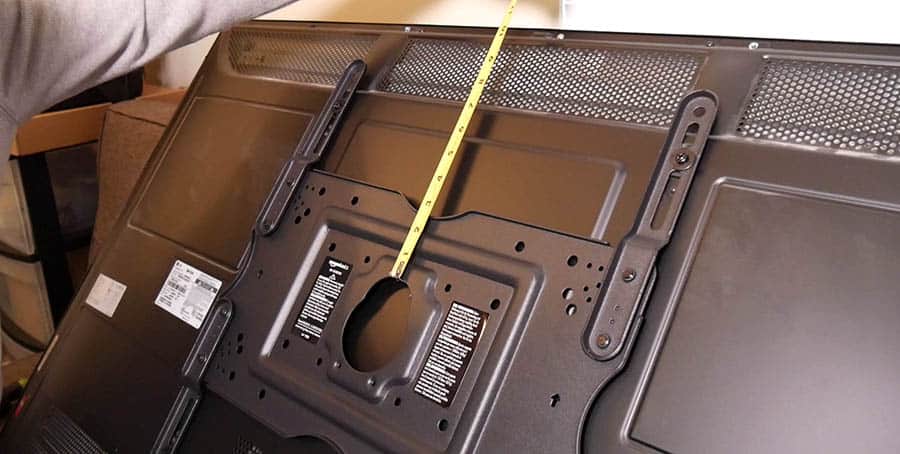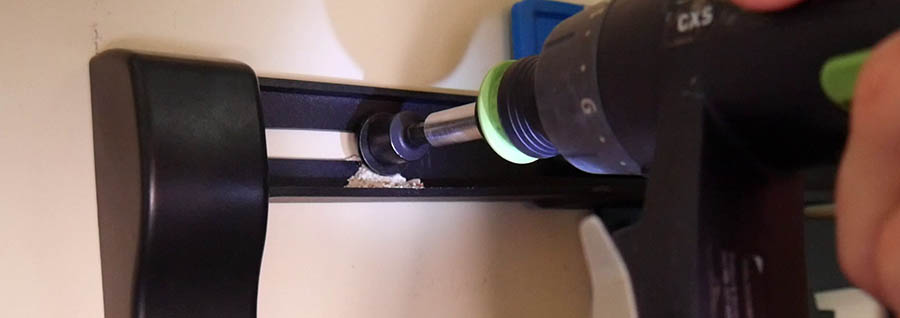What are the simple steps to mounting a TV? Once you’ve grabbed your tools, you’ll need less than an hour to have a safe and securely mounted TV that stays well in its place until you’re ready to replace or move it. Here’s the step by step YouTube video we created for mounting a TV to a wall:
Things You’ll Need to Mount a TV
To mount a TV properly, there are a few tools that you’ll need before you get started:
A TV wall mountTape measureDrillDrill bitsSocket wrench or impact drill/driverStud finderLevel
TV wall mounts come in a wide range of prices and sizes, and it’s important to make sure that the mount you choose is compatible with the TV you have. Drill bits will be used to drill into the studs of the wall to anchor the mount into the wall. A socket wrench or impact drill/driver is used to completely tighten the A stud finder can be put up against the wall and used to scan across and find the correct studs. A standalone level is your best bet for leveling your mounted TV, even if your mount comes with a level. The levels included are usually cheap and less reliable. Lastly, your TV is needed. You’ll want to make sure to know how much your TV weighs so that you know for sure that you have a mount that can properly support its weight.
1. Unbox the Mount
Begin unboxing the mount. Remove all the needed parts from the packaging, making sure to keep everything organized for your installation. Sometimes, the instruction manual will include a layout, which can help you in diagramming where everything goes. You can even tape it up to the wall, then use it as a guide for figuring out where to drill your holes, once you know where your studs are.
2. Attach the Bracket(s) to Your TV
There will be four different screw holes on the back of the TV. There are a bunch of different patterns that you may have, such as 400mm x 400mm or 600mm x 400mm, but most mounts are going to work with all of these. Assemble your bracket’s components, then attach the bracket to the TV using the correct provided screws and washers. There should be a number of different options available to fit different TV sizes. It’s important to make sure to not strip the screws, so you’ll want to use a drill with a limit on it, which keeps you from stripping them. If you don’t have a limit on your drill, just be extra careful when drilling. To drill in each screw and washer, be sure to push up on the bracket while you drill to tighten and secure the screws properly. Once you’ve drilled in your four screws, feel the fit of the bracket to make sure it’s fully secured. Once this is complete, you can get ready to hang the TV on the wall.
3. Measure the TV & Mount
Now you want to measure from the top of the bracket (where it sits on the mount) to the top of the TV. In the tutorial video, it’s about 11.5 inches. Next, you want to measure from the center of the mount to the top of the mount, which was about 4.5 inches in the tutorial video. Then subtract the first number from the second to find out how far the top of the TV will be from the top of the mount. Ex: 11.5 in – 4.5 in = 7 in. Therefore, the top of the TV will be 7 inches above the top of the mount. This makes it easier to mark where you want the top of the mount to be.
4. Decide How High You Want Your TV
Now that you know how far the top of the TV is from the top of the mount, you’ll want to look on the wall to figure out how high you want your TV to be. Usually, you’ll want your eyes centered on the television when you’re looking up at it from your seat. However, in most situations, this doesn’t exactly look normal. A TV at this height will look very low to most people, so it’s up to you as to the exact height that you mount the TV. Using this logic, find out where you want the top of the TV to be, then use your tape measure to find out where the top of the mount will be. Remember this area by keeping your hand there or lightly marking it with a dull pencil.
5. Find & Mark Your Studs
Next, take your stud finder and a pencil to mark out the studs on the wall. The bolt holes will be slightly below where the top of the mount is. Scan across the wall at the height where your screw holes will be. Find and mark the studs with your pencil. Feel free to make a few marks to make sure everything is lined up as best as possible.
6. Line Up the Studs With the Mount
Now that your studs are marked up on the wall, you’ll need to line up your studs with the mount. Your mount may have multiple holes for your bolts, or you may be limited to two areas like in the picture above.
If for some reason you can’t line up some of your bolts with the studs, you’ll want to make sure to use heavy-duty dry-wall anchors to properly secure these areas.
Please note: you should always hit at least one stud when mounting a TV, either on the left or right side. Do not try to mount a TV only with drywall anchors!
7. Drill Your First Hole
Before you drill your first hole, you’ll want to choose a drill bit that is slightly smaller than the bolt that goes into the wall. The bolt’s thread needs to be much further out than your bit (in size, measured up against each other), and the base of the bolt needs to be slightly bigger than the bit. Make sure your drill bit is centered and drill your first hole with the bit.
8. Make Sure the Mount is Level and Attach it to the Wall
You can attach your mount to the wall in a few different ways. You can measure out all of the locations for your holes and drill them before you screw in your bolts. I don’t really recommend this method because there is a lot of room for error. The best method is to place the mount where it should go on the wall and slightly tighten the first bolt into the stud. You can then use your level to ensure the mount is level to the ground and mark your second hole to drill. The first bolt will help you keep the mount in place while you drill the second hole. Note: Always make sure you use a washer between the bolt and the mount!
9. Drill Your Second Hole
Grab your level and place it on top of your mount. Line up your mount with your other stud mark. When it is level and lined up, drill in your second hole with your drill bit, then screw the next bolt in.
10. Drill Remaining Holes & Bolts
Keeping the level on your mount, drill the remaining holes with your drill bit, lined up with your studs. Then drill in the final bolts.
11. Tighten the Bolts
Now that all of your bolts are in, you’ll want to do the final tightening of your bolts, while the level is still on the mount to ensure that your mount is still level. After this, your mount will be fully secured to the wall. When tightening the bolts all the way, I suggest using a socket wrench or an impact drill/driver. Either one of these will make this a lot easier! Again, make sure you continually look at the level and ensure the mount stays level to the wall while tightening the bolts.
12. Place and Fasten the TV onto the Mount
After your mount is fully secured to the wall, it is time to put your TV and bracket onto the mount. This step will vary from mount to mount. But the instructions do not change for most of them. For most mounts, you’ll place the brackets onto the mount, then use screws or some mechanism to lock the brackets onto the mount. Now the job is complete! Your TV is securely mounted to the wall. As long as you followed the steps in this article, you should be good to go!
TV Mounts 101
If you’re shopping for a TV mount, you may be wondering what types are available, what you’ll likely be spending, and what some good options are.
TV Mount Types
When it comes to TV mounts, there are three main types available on the market: fixed TV mounts, tilting TV mounts, and full-motion or articulating TV mounts. The type that you choose depends on your needs. Fixed TV mounts are ones that do not move no matter what, and tilting TV mounts are able to tilt your TV vertically, which can improve the viewing experience. Full motion TV mounts, also known as articulating, swivel, or extending arm TV mounts, come with an arm (or two) that folds into itself to go flat against the wall and extends out to adjust your TV horizontally and vertically. It also allows you to easily access the back of your TV for switching out cables if needed.
Pricing
Pricing for TV mounts can vary, and there is a wide range of prices. You can spend as little as $20 or as much as a few hundred dollars. When deciding which one is best for you, you’ll want to make sure it fits your TV weight and size and that it hits all your needs for features.
High-Rated Options
If you have any questions, please leave them in the box below. Happy mounting!











